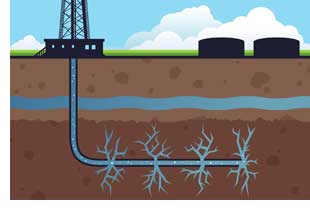Hydraulic Fracturing:
 Fracking,
or hydraulic fracturing, is the process of drilling and extracting natural gas and oil from deep in the earth. Water, mixed with
other components, is pumped into the ground to create cracks (also referred to as fissures or fractures) to release the gas into
wells that have been built for collection. Horizontal drilling (along with traditional vertical drilling) allows for the injection
of highly pressurized fracking fluids into the rock formations. This creates new channels within the rock from which natural gas
is extracted at higher than traditional rates.
Fracking,
or hydraulic fracturing, is the process of drilling and extracting natural gas and oil from deep in the earth. Water, mixed with
other components, is pumped into the ground to create cracks (also referred to as fissures or fractures) to release the gas into
wells that have been built for collection. Horizontal drilling (along with traditional vertical drilling) allows for the injection
of highly pressurized fracking fluids into the rock formations. This creates new channels within the rock from which natural gas
is extracted at higher than traditional rates.At the end of the job, the well is commonly flushed with water (sometimes blended with a friction reducing chemical) under pressure. Some of the injected fluid is recovered and is managed by several methods, such as underground injection control, treatment and discharge, recycling, or temporary storage in pits or containers while new technology is being developed to better handle wastewater and improve reusability. Although the concentrations of the chemical additives are low, the recovered fluid may be harmful due in part to toxicity of these chemicals and hydrocarbons picked up from the formation.
Water is the largest component of fracking fluids with initial drilling requiring 6,000-600,000 gallons of fracking fluids. Over its lifetime an average well will require up to an additional 5,000,000 gallons of water.
Groundwater protection is paramount to well operation. State and federal lawmakers are working to establish a system of rules to regulate the drilling. While most hydraulic fracturing activities are excluded from the Safe Drinking Water Act under the Energy Policy Act of 2005, hydraulic fracturing using diesel fuels is not and is subject to Safe Drinking Water Act requirements.
Contaminants of Concern:
The fluid, chemicals, and compressed gases that gas companies use during the fracking process can include water, sand, salt, citric acid, benzene, lead, ethylene glycol, methanol, boric acid, 2-butoxyethanol, nitrogen, and carbon dioxide. Chemical additives include biocides, surfactants, viscosity-modifiers, and emulsifiers. Gamma-emitting isotopes (radioactive) are also included in the fluid as tracers.These chemicals can be hazardous and have detrimental effects on the surrounding environment if not properly isolated and stored.
Implementing Solutions:
Please submit your experiences (successes/challenges) and tribal-specific documents to share on our website using the attached form.Download Form
Resources:
EPA's Underground Injection Control 101 Webinar for Tribal Representatives: EPA's Approach to Developing Permitting Guidance for Hydraulic Fracturing Using Diesel Fuels [pdf]EPA's Discussion with Tribal Representatives, June 2011: EPAs Approach to Developing Permitting Guidance for Oil and Gas Hydraulic Fracturing Activities Using Diesel Fuels [pdf]
EPA's Tribal Representatives Webinar on Hydraulic Fracturing Using Diesel Fuels Meeting Summary June 2, 2011 [pdf]
Websites:
EPA: Natural Gas Extraction – Hydraulic Fracking:www.epa.gov/hydraulicfracture/
Wikipedia: Hydraulic Fracturing:
en.wikipedia.org/wiki/Hydraulic_fracturing
Related Pages:
BrownfieldsContaminated Sites
Research Individual Chemicals
For more information, please contact:
Jennifer Williams, Alaska Program Coordinator, Sr.
Tel: 928/523-0673
Email: Jennifer.Williams@nau.edu
Tel: 928/523-0673
Email: Jennifer.Williams@nau.edu
Last updated: July 10, 2015
